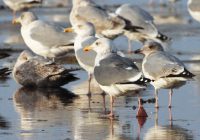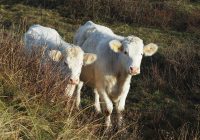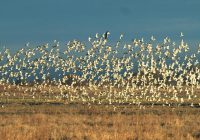Dr Phil Smith’s Wildlife Notes
December 2014
A series of gales in the first half of the month reduced opportunities for getting out and about but pushed large numbers of gulls inshore to roost between Ainsdale and Birkdale. On 13th, while studying a flock on Ainsdale beach from the car, I found several of the Scandinavian sub-species of both the Lesser Black-backed and Herring Gull. There was also a large dark-mantled, pink-legged Herring Gull type that I couldn’t immediately identify. Photographs were widely circulated, the general consensus being that it was probably a hybrid between Herring and Lesser Black-backed Gull, rather than an unlikely Vega Gull from eastern Siberia. It certainly caused me a lot of head-scratching.
Although it was a relatively damp month, a visit to Cabin Hill National Nature Reserve hoping to find wintering Snipe was disappointing. I counted only seven in the big slack which was almost entirely dry, the water-table being at least 30cm down on the normal winter level. About 55 Herdwick sheep and five Shetland Cattle were doing a great job grazing off the coarse vegetation. A primitive-breed, the Shetlands also love to browse large Grey Willow bushes, many showing signs of their activity, though they hadn’t touched the rare willow hybrid Salix× doniana, its bright red stems standing out vividly in the gloom.
Cattle are also being used for conservation grazing on Ainsdale Sandhills Local Nature Reserve. I went to see how the 15-strong herd of young Shorthorns and Belted Galloways are getting on. They are certainly having the desired effect, opening up the vegetation in the slacks and even creating small areas of bare ground on dune crests. These placid beasts largely ignored me, though to avoid any possible disturbance, I used a long lens to photograph them.
Calmer weather towards the month’s end saw me at Marshside, trying unsuccessfully to spot two Marsh Harriers reported on the saltmarsh. A Great White Egret was showing far out on the marsh, while a Sparrowhawk dashed past me. In front of the main hide, the long-staying Ross’s Goose, now in adult plumage, competed for my attention with a close-range Little Grebe. Then, a hulking Greater Black-backed Gull began to harass Wigeon on the inner marsh, their spectacular wheeling flocks flashing black and white in the low sun.
Back home, I was much entertained during the month by a flock of up to 15 cheerful House Sparrows coming to food just outside my lounge window. Once abundant, this charming bird declined by about 70% between 1977 and 2008, though populations seem to have levelled off since 2009. The reasons for their decline are complex but seem to include loss of nest sites and a shortage of insects to feed the young.
Purchasers of the otherwise excellent “fully revised and updated” edition of the Field Guide to the Dragonflies and Damselflies of Great Britain & Ireland by Brooks and Cham will find some dramatic changes in distribution since the book first appeared 17 years ago. Many of these are well established, with new arrivals in the country and other species spreading north, probably as a result of climate change. However, readers may be surprised to see that, according to the maps, Beautiful Demoiselle and Hairy Hawker are now found across a broad swathe of central Lancashire. Of course, this is complete nonsense! As confirmed by the regional recorder, Steve White, there have only been two acceptable records of Beautiful Demoiselle in Lancashire, both extra-limital vagrants, while Hairy Hawker has never been confirmed in the county. This problem has arisen because the national Dragonfly Atlas, published in May, included unsubstantiated claims of both these species in Lancashire. They have simply been copied into the new field guide, showing how easy it is for incorrect information to be enshrined in the literature. Hopefully, the new Lancashire Atlas, to be published later this year, will correct these mistakes.




